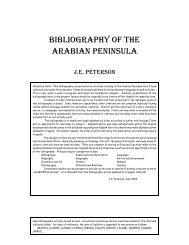THE ARABIAN PENINSULA IN MODERN TIMES: A - JEPeterson.net
THE ARABIAN PENINSULA IN MODERN TIMES: A - JEPeterson.net
THE ARABIAN PENINSULA IN MODERN TIMES: A - JEPeterson.net
You also want an ePaper? Increase the reach of your titles
YUMPU automatically turns print PDFs into web optimized ePapers that Google loves.
a more recent article. 38<br />
Boundaries and Legal Matters. Boundaries in the Arabian Peninsula have been one of the<br />
principal legal problems over the course of the 20 th century, a point underscored by Richard<br />
Schofield, John Wilkinson, Ibrahim Ibrahim, and Husain Albaharna. 39 The British‐sponsored<br />
1922 conference at al‐‘Uqayr (now in Saudi Arabia) established the outline of borders between<br />
Saudi Arabia, Kuwait, and Iraq, as well as two Neutral Zones, as Eran Segal discusses and<br />
Anthony Toth elucidates the tribal aspect of the divisions. Yitzhak Gil‐Har points out that the<br />
British also played a major role in delineating the Saudi‐Jordanian border. John Willis has<br />
examined the question of borders in Yemen, including between former North and South<br />
Yemen. Most borders have been settled by comprehensive agreements in recent years –<br />
among them the Saudi‐Yemeni border, which has been studied by Askar Al Enazy and in the<br />
book edited by Renaud Detalle. 40 So have most of the most contentious issues, such as the<br />
Saudi claims to al‐Buraymi oasis (subject of an article by Tore Tingvold Petersen), the dispute<br />
between Bahrain and Qatar over islands and the enclave of Zubarah (examined from a Bahraini<br />
point of view by the edited work by Jawad al‐Arayed), and Iraq’s claim to Kuwait (which has<br />
spawned a large literature, headed by studies by Richard Schofield, Maurice Mendelson and<br />
Susan Hulton, David Finnie, and Habibur Rahman). 41 But one dispute that continues to fester is<br />
38. Claudie Fayein, “Le Yémen imamite dans les années cinquante,” Cahiers du GREMAMO, Vol. 10 (1991), pp.<br />
167-170; Sultan b. Muhammad al-Qasimi, The White Shaikh (Sharjah, privately printed, November 1996; also<br />
published in Arabic); Thomas Barger, Out in the Blue: Letters from Arabia, 1937-1940 (N.p., 2000); Fahd al-<br />
Semmari and Jill A. Roberg, eds., Michael Crocker, comp., Forever Friends: Americans Share Their Fondest<br />
Memories of Work Life in the Kingdom of Saudi Arabia, 1938-1998 (2nd ed.; Riyadh: King Abdulaziz Foundation<br />
for Research and Archives, 2000); Aileen Keating, Mirage: Power, Politics, and the Hidden History of Arabian Oil<br />
(Amherst, NY: Prometheus Books, 2005).<br />
39. John Wilkinson, Arabia’s Frontiers: The Story of Britain’s Blue and Violet Lines (London: I.B. Tauris; New<br />
York: St. Martin’s Press, 1991); Ibrahim Ibrahim, “Sovereign States and Borders in the Gulf Region: A Historical<br />
Perspective,” in Ibrahim Ibrahim, ed., The Gulf Crisis: Background and Consequences (Washington: Georgetown<br />
University Center for Contemporary Arab Studies, 1992), pp. 3-17; Richard Schofield, ed., Territorial Foundations<br />
of the Gulf States (London: University College of London Press, 1994); ibid., “Down to the Usual Suspects: Border<br />
and Territorial Disputes in the Arabian Peninsula and Persian Gulf at the Millennium,” in Joseph A. Kechichian, ed.,<br />
Iran, Iraq, and the Arab Gulf States (New York: Palgrave, 2001), pp. 213-236; Husain M. Albaharna, British<br />
Extraterritorial Jurisdiction in the Gulf, 1913-1971 (Slough, UK: Archive Editions, 1998).<br />
40. Yitzhak Gil-Har, “Delimitation Boundaries: TransJordan and Saudi Arabia,” Middle Eastern Studies, Vol. 28,<br />
No. 2 (1992), pp. 374-384; Renaud Detalle, ed., Tensions in Arabia: The Saudi-Yemeni Faultline (Baden-Baden:<br />
Nomos Verlagsgesellschaft, 2000); Anthony B. Toth, “The Transformation of a Pastoral Economy: Bedouin and<br />
States in Northern Arabia, 1850-1950” (D.Phil. thesis, Oxford University, 2002); ibid., “Conflict and a Pastoral<br />
Economy: The Costs of Akhwan Attacks on Tribes in Iraq, 1922-29” Critique, Vol. 11, No. 2 (September 2002),<br />
pp. 201-227; ibid., “Tribes and Tribulations: Bedouin Losses in the Saudi and Iraqi Struggles Over Kuwait’s<br />
Frontiers, 1921-1943,” British Journal of Middle Eastern Studies, Vol. 32, No. 2 (November 2005), pp. 145-168;<br />
Askar H. Al Enazy, The Long Road from Taif to Jeddah: Resolution of a Saudi-Yemeni Boundary Dispute (Abu<br />
Dhabi: Emirates Center for Strategic Studies and Research, 2005); John M. Willis, “Unmaking North and South:<br />
Spatial Histories of Modern Yemen” (Ph.D. dissertation, New York University, 2007); ibid., “Leaving Only<br />
QuestionMarks: Geographies of Rule in Modern Yemen,” in Robert Vitalis and Madawi al-Rasheed, eds.,<br />
CounterNarratives: History, Contemporary Society, and Politics in Saudi Arabia and Yemen (New York: Palgrave,<br />
2004), pp. 119-150; Eran Segal, “The Uqair Conference (1922) Revisited: Britain and the Question of Boundaries<br />
in the Arabian Peninsula,” in Zoch Levey and Elie Podeh, eds., Britain and the Middle East: From Imperial Power<br />
to Junior Partner (Brighton: Sussex Academic Press, 2008), pp. 231-247. Although not dealing with border<br />
questions, a study on a somewhat related legal topic is Bernard Haykel, “Al-Shawkani and the Jurisprudential Unity<br />
of Yemen,” Revue du Monde Musulman et de la Mediterranée, No. 67 (1993), pp. 53-65.<br />
41. Maurice Mendelson and Susan C. Hulton, “La revendication par l’Irak de la souverai<strong>net</strong>é,” Annuaire Français<br />
12







